Xiaodan Liang
CurveLane-NAS: Unifying Lane-Sensitive Architecture Search and Adaptive Point Blending
Jul 23, 2020


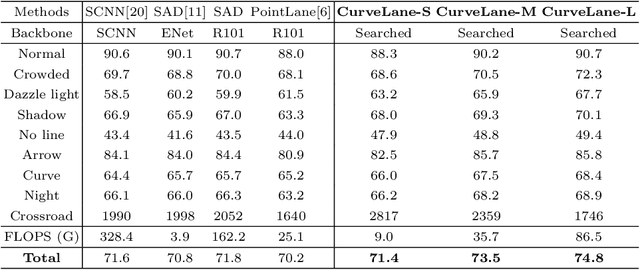
Abstract:We address the curve lane detection problem which poses more realistic challenges than conventional lane detection for better facilitating modern assisted/autonomous driving systems. Current hand-designed lane detection methods are not robust enough to capture the curve lanes especially the remote parts due to the lack of modeling both long-range contextual information and detailed curve trajectory. In this paper, we propose a novel lane-sensitive architecture search framework named CurveLane-NAS to automatically capture both long-ranged coherent and accurate short-range curve information while unifying both architecture search and post-processing on curve lane predictions via point blending. It consists of three search modules: a) a feature fusion search module to find a better fusion of the local and global context for multi-level hierarchy features; b) an elastic backbone search module to explore an efficient feature extractor with good semantics and latency; c) an adaptive point blending module to search a multi-level post-processing refinement strategy to combine multi-scale head prediction. The unified framework ensures lane-sensitive predictions by the mutual guidance between NAS and adaptive point blending. Furthermore, we also steer forward to release a more challenging benchmark named CurveLanes for addressing the most difficult curve lanes. It consists of 150K images with 680K labels.The new dataset can be downloaded at github.com/xbjxh/CurveLanes (already anonymized for this submission). Experiments on the new CurveLanes show that the SOTA lane detection methods suffer substantial performance drop while our model can still reach an 80+% F1-score. Extensive experiments on traditional lane benchmarks such as CULane also demonstrate the superiority of our CurveLane-NAS, e.g. achieving a new SOTA 74.8% F1-score on CULane.
CATCH: Context-based Meta Reinforcement Learning for Transferrable Architecture Search
Jul 22, 2020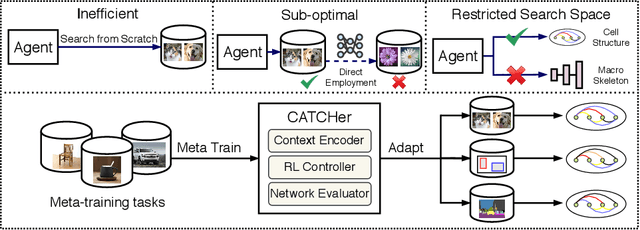

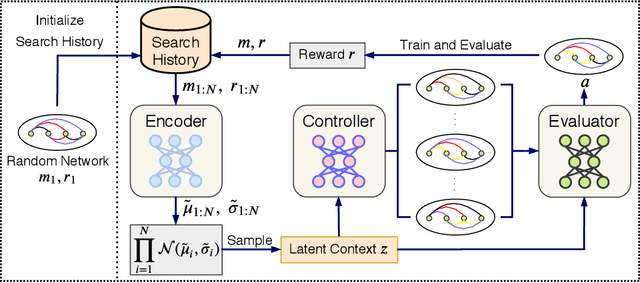

Abstract:Neural Architecture Search (NAS) achieved many breakthroughs in recent years. In spite of its remarkable progress, many algorithms are restricted to particular search spaces. They also lack efficient mechanisms to reuse knowledge when confronting multiple tasks. These challenges preclude their applicability, and motivate our proposal of CATCH, a novel Context-bAsed meTa reinforcement learning (RL) algorithm for transferrable arChitecture searcH. The combination of meta-learning and RL allows CATCH to efficiently adapt to new tasks while being agnostic to search spaces. CATCH utilizes a probabilistic encoder to encode task properties into latent context variables, which then guide CATCH's controller to quickly "catch" top-performing networks. The contexts also assist a network evaluator in filtering inferior candidates and speed up learning. Extensive experiments demonstrate CATCH's universality and search efficiency over many other widely-recognized algorithms. It is also capable of handling cross-domain architecture search as competitive networks on ImageNet, COCO, and Cityscapes are identified. This is the first work to our knowledge that proposes an efficient transferrable NAS solution while maintaining robustness across various settings.
Auxiliary Signal-Guided Knowledge Encoder-Decoder for Medical Report Generation
Jun 06, 2020
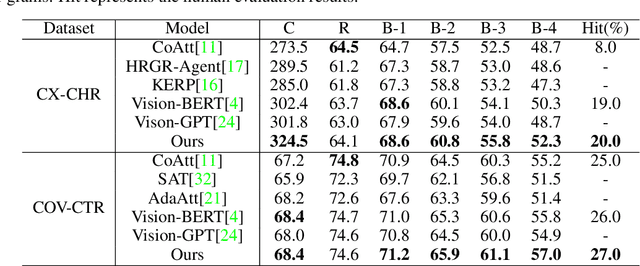

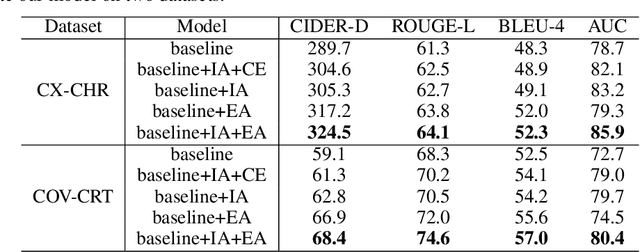
Abstract:Beyond the common difficulties faced in the natural image captioning, medical report generation specifically requires the model to describe a medical image with a fine-grained and semantic-coherence paragraph that should satisfy both medical commonsense and logic. Previous works generally extract the global image features and attempt to generate a paragraph that is similar to referenced reports; however, this approach has two limitations. Firstly, the regions of primary interest to radiologists are usually located in a small area of the global image, meaning that the remainder parts of the image could be considered as irrelevant noise in the training procedure. Secondly, there are many similar sentences used in each medical report to describe the normal regions of the image, which causes serious data bias. This deviation is likely to teach models to generate these inessential sentences on a regular basis. To address these problems, we propose an Auxiliary Signal-Guided Knowledge Encoder-Decoder (ASGK) to mimic radiologists' working patterns. In more detail, ASGK integrates internal visual feature fusion and external medical linguistic information to guide medical knowledge transfer and learning. The core structure of ASGK consists of a medical graph encoder and a natural language decoder, inspired by advanced Generative Pre-Training (GPT). Experiments on the CX-CHR dataset and our COVID-19 CT Report dataset demonstrate that our proposed ASGK is able to generate a robust and accurate report, and moreover outperforms state-of-the-art methods on both medical terminology classification and paragraph generation metrics.
Bidirectional Graph Reasoning Network for Panoptic Segmentation
Apr 14, 2020
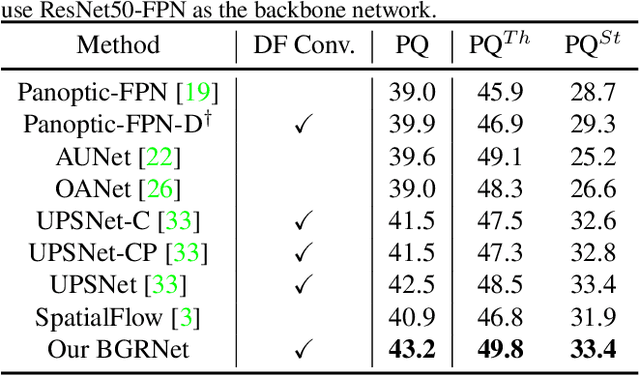


Abstract:Recent researches on panoptic segmentation resort to a single end-to-end network to combine the tasks of instance segmentation and semantic segmentation. However, prior models only unified the two related tasks at the architectural level via a multi-branch scheme or revealed the underlying correlation between them by unidirectional feature fusion, which disregards the explicit semantic and co-occurrence relations among objects and background. Inspired by the fact that context information is critical to recognize and localize the objects, and inclusive object details are significant to parse the background scene, we thus investigate on explicitly modeling the correlations between object and background to achieve a holistic understanding of an image in the panoptic segmentation task. We introduce a Bidirectional Graph Reasoning Network (BGRNet), which incorporates graph structure into the conventional panoptic segmentation network to mine the intra-modular and intermodular relations within and between foreground things and background stuff classes. In particular, BGRNet first constructs image-specific graphs in both instance and semantic segmentation branches that enable flexible reasoning at the proposal level and class level, respectively. To establish the correlations between separate branches and fully leverage the complementary relations between things and stuff, we propose a Bidirectional Graph Connection Module to diffuse information across branches in a learnable fashion. Experimental results demonstrate the superiority of our BGRNet that achieves the new state-of-the-art performance on challenging COCO and ADE20K panoptic segmentation benchmarks.
Linguistically Driven Graph Capsule Network for Visual Question Reasoning
Mar 23, 2020
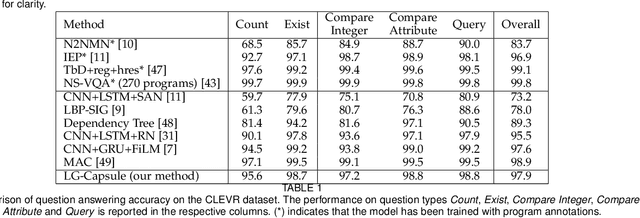

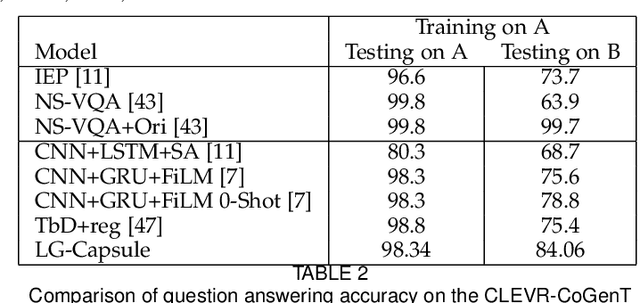
Abstract:Recently, studies of visual question answering have explored various architectures of end-to-end networks and achieved promising results on both natural and synthetic datasets, which require explicitly compositional reasoning. However, it has been argued that these black-box approaches lack interpretability of results, and thus cannot perform well on generalization tasks due to overfitting the dataset bias. In this work, we aim to combine the benefits of both sides and overcome their limitations to achieve an end-to-end interpretable structural reasoning for general images without the requirement of layout annotations. Inspired by the property of a capsule network that can carve a tree structure inside a regular convolutional neural network (CNN), we propose a hierarchical compositional reasoning model called the "Linguistically driven Graph Capsule Network", where the compositional process is guided by the linguistic parse tree. Specifically, we bind each capsule in the lowest layer to bridge the linguistic embedding of a single word in the original question with visual evidence and then route them to the same capsule if they are siblings in the parse tree. This compositional process is achieved by performing inference on a linguistically driven conditional random field (CRF) and is performed across multiple graph capsule layers, which results in a compositional reasoning process inside a CNN. Experiments on the CLEVR dataset, CLEVR compositional generation test, and FigureQA dataset demonstrate the effectiveness and composition generalization ability of our end-to-end model.
Vision-Dialog Navigation by Exploring Cross-modal Memory
Mar 15, 2020

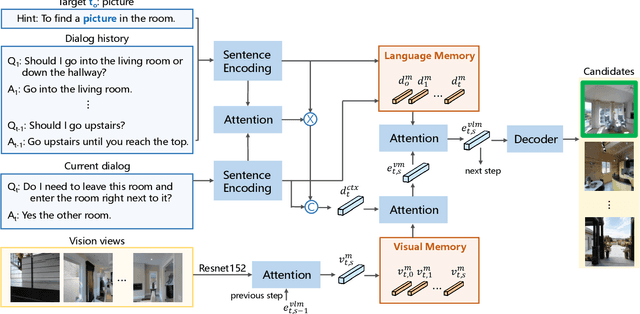

Abstract:Vision-dialog navigation posed as a new holy-grail task in vision-language disciplinary targets at learning an agent endowed with the capability of constant conversation for help with natural language and navigating according to human responses. Besides the common challenges faced in visual language navigation, vision-dialog navigation also requires to handle well with the language intentions of a series of questions about the temporal context from dialogue history and co-reasoning both dialogs and visual scenes. In this paper, we propose the Cross-modal Memory Network (CMN) for remembering and understanding the rich information relevant to historical navigation actions. Our CMN consists of two memory modules, the language memory module (L-mem) and the visual memory module (V-mem). Specifically, L-mem learns latent relationships between the current language interaction and a dialog history by employing a multi-head attention mechanism. V-mem learns to associate the current visual views and the cross-modal memory about the previous navigation actions. The cross-modal memory is generated via a vision-to-language attention and a language-to-vision attention. Benefiting from the collaborative learning of the L-mem and the V-mem, our CMN is able to explore the memory about the decision making of historical navigation actions which is for the current step. Experiments on the CVDN dataset show that our CMN outperforms the previous state-of-the-art model by a significant margin on both seen and unseen environments.
Learning Reinforced Agents with Counterfactual Simulation for Medical Automatic Diagnosis
Mar 14, 2020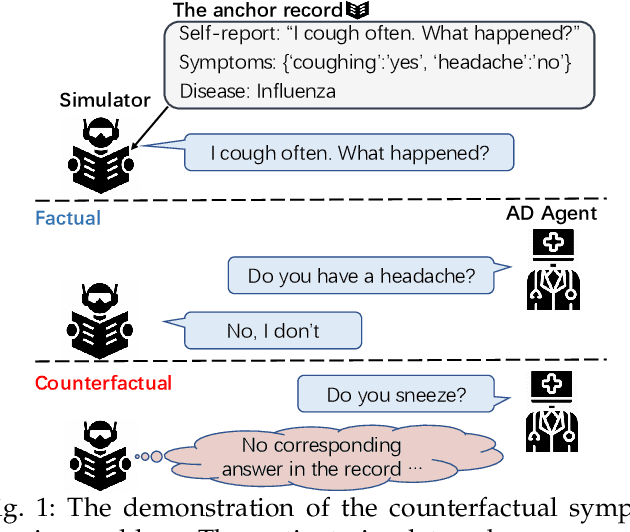
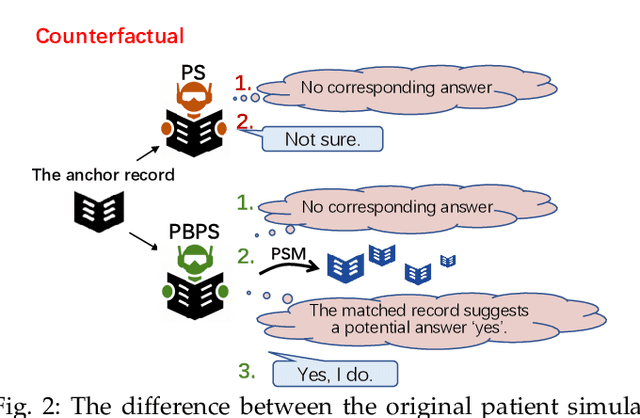

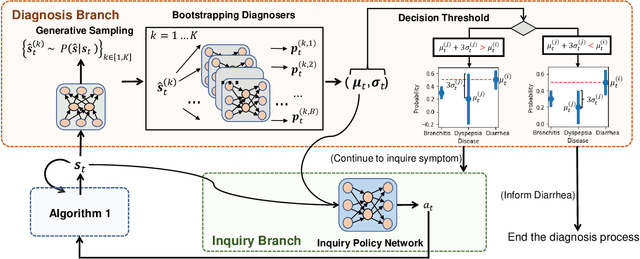
Abstract:Medical automatic diagnosis (MAD) aims to learn an agent that mimics the behavior of a human doctor, i.e. inquiring symptoms and informing diseases. Due to medical ethics concerns, it is impractical to directly apply reinforcement learning techniques to solving MAD, e.g., training a reinforced agent with the human patient. Developing a patient simulator by using the collected patient-doctor dialogue records has been proposed as a promising approach to MAD. However, most of these existing works overlook the causal relationship between patient symptoms and disease diagnoses. For example, these simulators simply generate the ``not-sure'' response to the inquiry (i.e., symptom) that was not observed in one dialogue record. As a result, the MAD agent is usually trained without exploiting the counterfactual reasoning beyond the factual observations. To address this problem, this paper presents a propensity-based patient simulator (PBPS), which is capable of facilitating the training of MAD agents by generating informative counterfactual answers along with the disease diagnosis. Specifically, our PBPS estimates the propensity score of each record with the patient-doctor dialogue reasoning, and can thus generate the counterfactual answers by searching across records. That is, the unrecorded symptom for one patient can be found in the records of other patients according to the propensity score matching. A progressive assurance agent (P2A) can be thus trained with PBPS, which includes two separate yet cooperative branches accounting for the execution of symptom-inquiry and disease-diagnosis actions, respectively. The disease-diagnosis predicts the confidence of disease and drives the symptom-inquiry in terms of enhancing the confidence, and the two branches are jointly optimized with benefiting from each other.
Dynamic Knowledge Routing Network For Target-Guided Open-Domain Conversation
Mar 06, 2020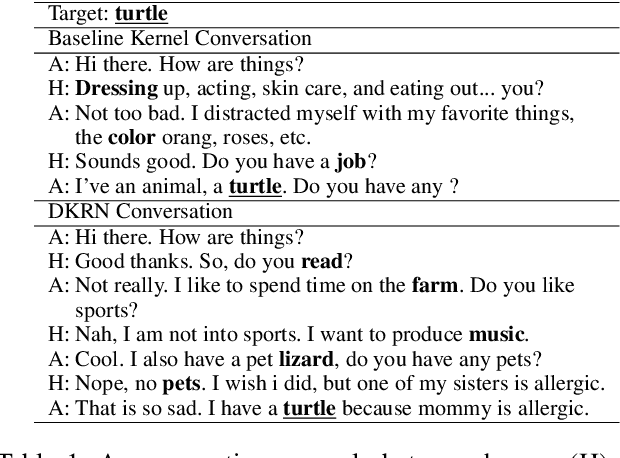



Abstract:Target-guided open-domain conversation aims to proactively and naturally guide a dialogue agent or human to achieve specific goals, topics or keywords during open-ended conversations. Existing methods mainly rely on single-turn datadriven learning and simple target-guided strategy without considering semantic or factual knowledge relations among candidate topics/keywords. This results in poor transition smoothness and low success rate. In this work, we adopt a structured approach that controls the intended content of system responses by introducing coarse-grained keywords, attains smooth conversation transition through turn-level supervised learning and knowledge relations between candidate keywords, and drives an conversation towards an specified target with discourse-level guiding strategy. Specially, we propose a novel dynamic knowledge routing network (DKRN) which considers semantic knowledge relations among candidate keywords for accurate next topic prediction of next discourse. With the help of more accurate keyword prediction, our keyword-augmented response retrieval module can achieve better retrieval performance and more meaningful conversations. Besides, we also propose a novel dual discourse-level target-guided strategy to guide conversations to reach their goals smoothly with higher success rate. Furthermore, to push the research boundary of target-guided open-domain conversation to match real-world scenarios better, we introduce a new large-scale Chinese target-guided open-domain conversation dataset (more than 900K conversations) crawled from Sina Weibo. Quantitative and human evaluations show our method can produce meaningful and effective target-guided conversations, significantly improving over other state-of-the-art methods by more than 20% in success rate and more than 0.6 in average smoothness score.
ElixirNet: Relation-aware Network Architecture Adaptation for Medical Lesion Detection
Mar 03, 2020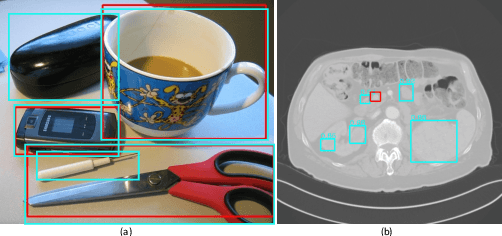



Abstract:Most advances in medical lesion detection network are limited to subtle modification on the conventional detection network designed for natural images. However, there exists a vast domain gap between medical images and natural images where the medical image detection often suffers from several domain-specific challenges, such as high lesion/background similarity, dominant tiny lesions, and severe class imbalance. Is a hand-crafted detection network tailored for natural image undoubtedly good enough over a discrepant medical lesion domain? Is there more powerful operations, filters, and sub-networks that better fit the medical lesion detection problem to be discovered? In this paper, we introduce a novel ElixirNet that includes three components: 1) TruncatedRPN balances positive and negative data for false positive reduction; 2) Auto-lesion Block is automatically customized for medical images to incorporate relation-aware operations among region proposals, and leads to more suitable and efficient classification and localization. 3) Relation transfer module incorporates the semantic relationship and transfers the relevant contextual information with an interpretable the graph thus alleviates the problem of lack of annotations for all types of lesions. Experiments on DeepLesion and Kits19 prove the effectiveness of ElixirNet, achieving improvement of both sensitivity and precision over FPN with fewer parameters.
Universal-RCNN: Universal Object Detector via Transferable Graph R-CNN
Feb 18, 2020



Abstract:The dominant object detection approaches treat each dataset separately and fit towards a specific domain, which cannot adapt to other domains without extensive retraining. In this paper, we address the problem of designing a universal object detection model that exploits diverse category granularity from multiple domains and predict all kinds of categories in one system. Existing works treat this problem by integrating multiple detection branches upon one shared backbone network. However, this paradigm overlooks the crucial semantic correlations between multiple domains, such as categories hierarchy, visual similarity, and linguistic relationship. To address these drawbacks, we present a novel universal object detector called Universal-RCNN that incorporates graph transfer learning for propagating relevant semantic information across multiple datasets to reach semantic coherency. Specifically, we first generate a global semantic pool by integrating all high-level semantic representation of all the categories. Then an Intra-Domain Reasoning Module learns and propagates the sparse graph representation within one dataset guided by a spatial-aware GCN. Finally, an InterDomain Transfer Module is proposed to exploit diverse transfer dependencies across all domains and enhance the regional feature representation by attending and transferring semantic contexts globally. Extensive experiments demonstrate that the proposed method significantly outperforms multiple-branch models and achieves the state-of-the-art results on multiple object detection benchmarks (mAP: 49.1% on COCO).
 Add to Chrome
Add to Chrome Add to Firefox
Add to Firefox Add to Edge
Add to Edge